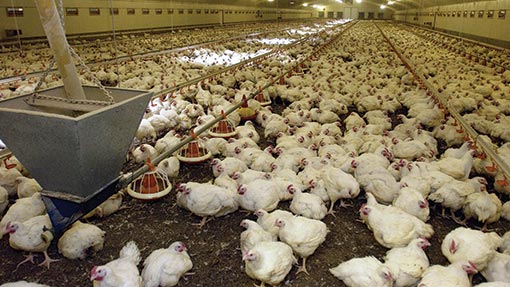Rearing broilers proves to be a viable alternative to dairy herd expansion

A broiler enterprise has provided a profitable alternative to herd expansion on a Northern Ireland dairy farm, where expansion is being limited by the lack of land to rent.
Father and son Samuel and Thomas Dickson had been exploring opportunities for adding income to the dairy enterprise. Thomas was supplementing his income with off-farm agricultural work, but he was keen to be at home full-time.
At 85ha, the land base of their County Armagh farm ruled out herd expansion. Cow numbers currently run at 140 and the Dicksons also keep all their bulls for fattening as well as buying in store lambs to fatten over the winter.
“To get the income we needed we would have to increase the herd to 200 cows. There are a large number of dairy farms in our area and rented ground is hard to come by,” Thomas explains.
See also: Moy Park may be listed on London Stock Exchange
The Dicksons then considered the option of diversifying into poultry. As a teenager, Thomas had worked on a poultry farm for several years and had retained that interest.
They firstly looked at egg production, but the long hours and land needed for free-range production was a barrier.
“If we went down the free-range route we would need up to seven acres per house so it would have taken too much land away from the farm.
“We then looked at broiler production and after speaking to producers we decided it was the way to go,” says Thomas.
They invested £520,000 in establishing housing for 46,000 high-welfare birds. This only required 0.8ha of land.
Securing planning permission was very straightforward. “We were warned that planning could be a nightmare but there were no objections, our plans went straight through,” says Thomas. “The whole thing took us seven months to establish, from start to finish.”
Thomas admits the new enterprise was initially challenging. “We were spending a lot of time with the birds to make sure they were well and healthy, but now we have been at it for a year and a half we know what to look out for. We almost know the day before an illness occurs. The enterprise ties in very well with the rest of the farm; we just start a little earlier in the mornings.”
An NVQ in poultry production, which involved a day’s training once a fortnight for seven months, was invaluable. “We were skeptical at first but it was a great help,” says Thomas.
He takes most of the responsibility for the broilers while Samuel focuses on the dairy enterprise.
The birds are supplied to Waitrose through Moy Park. The close relationship the Dicksons have with Moy Park has been integral to the success of the diversification.
“When we were starting out and unsure of what we were doing, Moy Park assigned field staff members to us. It was reassuring to know that there were poultry experts on hand to guide us,” says Thomas.
And that support has continued. “When we get a new delivery of birds a field officer will come and take a look at them to make sure everything is OK.”
The birds’ water consumption is monitored daily, as this is a good indicator of bird health. “The water is always consumed at a steady rate so if that changes in any way it is a sign that something is not right,” says Thomas.
And according to the Moy Park league table of broiler producers, Dickson Poultry is doing well. The business is ranked at 14. “We are getting a good income from it,’’ Thomas admits.
So much so that in two years’ time they hope to increase production. Planning permission will be sought for an additional shed to house 23,000 birds.
Thomas’ advice to other dairy farmers who think broiler production might be a good fit for their businesses is to make sure they have the time needed to make a success of this type of business.
“You have got to put in the time, it is no good combining it with working off the farm. I walk through the sheds twice a day but during the day I will be up and down an additional two or three times because you never know when you are going to get a burst pipe or when the feed line might break down.”
